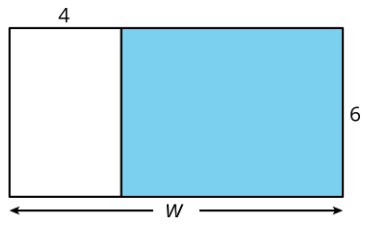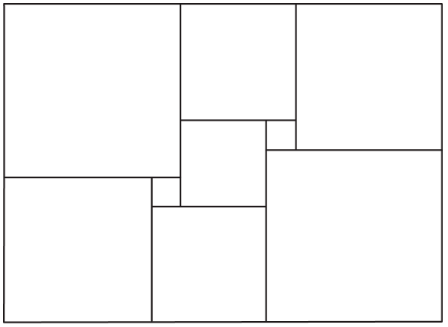32.6: The Distributive Property, Part 3
- Page ID
- 40606
Lesson
Let's practice writing equivalent expressions by using the distributive property.
Exercise \(\PageIndex{1}\): The Shaded Region
A rectangle with dimensions 6 cm and \(w\) cm is partitioned into two smaller rectangles.
Explain why each of these expressions represents the area, in cm2, of the shaded region.
- \(6w-24\)
- \(6(w-4)\)

Exercise \(\PageIndex{2}\): Matching to Practice Distributive Property
Match each expression in column 1 to an equivalent expression in column 2. If you get stuck, consider drawing a diagram.
Column 1
- \(a(1+2+3)\)
- \(2(12-4)\)
- \(12a+3b\)
- \(\frac{2}{3}(15a-18)\)
- \(6a+10b\)
- \(0.4(5-2.5a)\)
- \(2a+3a\)
Column 2
- \(3(4a+b)\)
- \(12\cdot 2-4\cdot 2\)
- \(2(3a+5b)\)
- \((2+3)a\)
- \(a+2a+4a\)
- \(10a-12\)
- \(2-a\)
Exercise \(\PageIndex{3}\): Writing Equivalent Expressions Using the Distributive Property
The distributive property can be used to write equivalent expressions. In each row, use the distributive property to write an equivalent expression. If you get stuck, consider drawing a diagram.
| product | sum or difference |
|---|---|
| \(3(3+x)\) | |
| \(4x-20\) | |
| \((9-5)x\) | |
| \(4x+7x\) | |
| \(3(2x+1)\) | |
| \(10x-5\) | |
| \(x+2x+3x\) | |
| \(\frac{1}{2}(x-6)\) | |
| \(y(3x+4z)\) | |
| \(2xyz-3yz+4xz\) |
Are you ready for more?
This rectangle has been cut up into squares of varying sizes. Both small squares have side length 1 unit. The square in the middle has side length \(x\) units.

- Suppose that \(x\) is 3. Find the area of each square in the diagram. Then find the area of the large rectangle.
- Find the side lengths of the large rectangle assuming that \(x\) is 3. Find the area of the large rectangle by multiplying the length times the width. Check that this is the same area you found before.
- Now suppose that we do not know the value of \(x\). Write an expression for the side lengths of the large rectangle that involves \(x\).
Summary
The distributive property can be used to write a sum as a product, or write a product as a sum. You can always draw a partitioned rectangle to help reason about it, but with enough practice, you should be able to apply the distributive property without making a drawing.
Here are some examples of expressions that are equivalent due to the distributive property.
\(\begin{aligned} 9+18&= 9(1+2) \\ 2(3x+4)&=6x+8 \\ 2n+3n+n&=n(2+3+1) \\ 11b-99a&= 11(b-9a) \\ k(c+d-e)&=kc+kd-ke\end{aligned}\)
Glossary Entries
Definition: Equivalent Expressions
Equivalent expressions are always equal to each other. If the expressions have variables, they are equal whenever the same value is used for the variable in each expression.
For example, \(3x+4x\) is equivalent to \(5x+2x\). No matter what value we use for \(x\), these expressions are always equal. When \(x\) is 3, both expressions equal 21. When \(x\) is 10, both expressions equal 70.
Definition: Term
A term is a part of an expression. It can be a single number, a variable, or a number and a variable that are multiplied together. For example, the expression \(5x+18\) has two terms. The first term is \(5x\) and the second term is 18.
Practice
Exercise \(\PageIndex{4}\)
For each expression, use the distributive property to write an equivalent expression.
- \(4(x+2)\)
- \((6+8)\cdot x\)
- \(4(2x+3)\)
- \(6(x+y+z)\)
Exercise \(\PageIndex{5}\)
Priya rewrites the expression \(8y-24\) as \(8(y-3)\). Han rewrites \(8y-24\) as \(2(4y-12)\). Are Priya's and Han's expressions each equivalent to \(8y-24\)? Explain your reasoning.
Exercise \(\PageIndex{6}\)
Select all the expressions that are equivalent to \(16x+36\).
- \(16(x+20)\)
- \(x(16+36)\)
- \(4(4x+9)\)
- \(2(8x+18)\)
- \(2(8x+36)\)
Exercise \(\PageIndex{7}\)
The area of a rectangle is \(30+12x\). List at least 3 possibilities for the length and width of the rectangle.
Exercise \(\PageIndex{8}\)
Select all the expressions that are equivalent to \(\frac{1}{2}z\).
- \(z+z\)
- \(z\div 2\)
- \(z\cdot z\)
- \(\frac{1}{4}z+\frac{1}{4}z\)
- \(2z\)
(From Unit 6.2.3)
Exercise \(\PageIndex{9}\)
- What is the perimeter of a square with side length:
3 cm?
7 cm?
\(s\) cm? - If the perimeter of a square is 360 cm, what is its side length?
- What is the area of a square with side length:
3 cm?
7 cm?
\(s\) cm? - If the area of a square is 121 cm2, what is its side length?
(From Unit 6.2.1)
Exercise \(\PageIndex{10}\)
Solve each equation.
\(10=4a\)
\(5b=17.5\)
\(1.036=10c\)
\(0.6d=1.8\)
\(15=0.1e\)
(From Unit 6.1.5)

